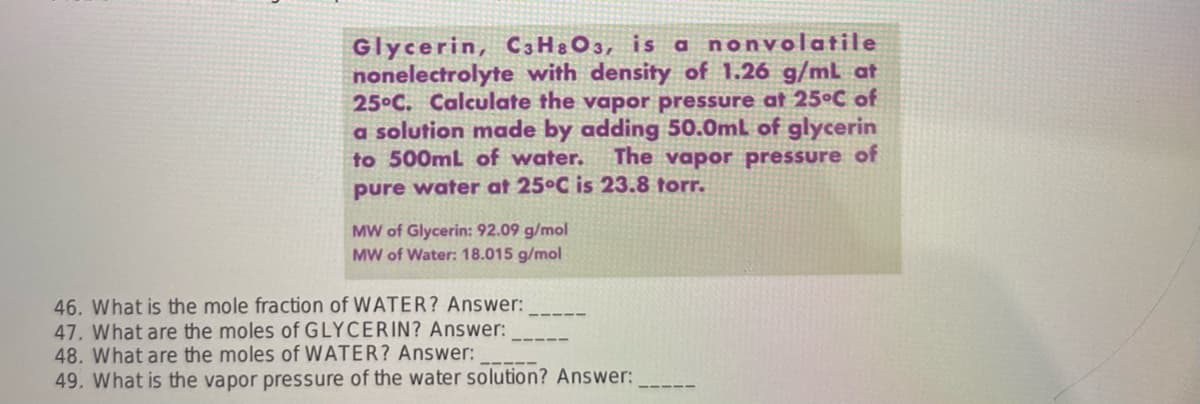Glycerin, C3H8O3, is a nonvolatile nonelectrolyte with density of 1.26 g/mL at 25°C. Calculate the vapor pressure at 25°C of a solution made by adding 50.0mL of glycerin to 500mL of water. The vapor pressure of pure water at 25°C is 23.8 torr. MW of Glycerin: 92.09 g/mol MW of Water: 18.015 g/mol 46. What is the mole fraction of WATER? Answer: 47. What are the moles of GLYCERIN? Answer: 48. What are the moles of WATER? Answer: 49. What is the vapor pressure of the water solution? Answer:
Glycerin, C3H8O3, is a nonvolatile nonelectrolyte with density of 1.26 g/mL at 25°C. Calculate the vapor pressure at 25°C of a solution made by adding 50.0mL of glycerin to 500mL of water. The vapor pressure of pure water at 25°C is 23.8 torr. MW of Glycerin: 92.09 g/mol MW of Water: 18.015 g/mol 46. What is the mole fraction of WATER? Answer: 47. What are the moles of GLYCERIN? Answer: 48. What are the moles of WATER? Answer: 49. What is the vapor pressure of the water solution? Answer:
Chemistry: An Atoms First Approach
2nd Edition
ISBN:9781305079243
Author:Steven S. Zumdahl, Susan A. Zumdahl
Publisher:Steven S. Zumdahl, Susan A. Zumdahl
Chapter10: Properties Of Solutions
Section: Chapter Questions
Problem 61E: Which of the following will have the lowest total vapor pressure at 25C? a. pure water (vapor...
Related questions
Question

Transcribed Image Text:Glycerin, C3H8O3, is a nonvolatile
nonelectrolyte with density of 1.26 g/mL at
25°C. Calculate the vapor pressure at 25°C of
a solution made by adding 50.0mL of glycerin
to 500mL of water. The vapor pressure of
pure water at 25°C is 23.8 torr.
MW of Glycerin: 92.09 g/mol
MW of Water: 18.015 g/mol
46. What is the mole fraction of WATER? Answer:
47. What are the moles of GLYCERIN? Answer:
48. What are the moles of WATER? Answer:
49. What is the vapor pressure of the water solution? Answer:
Expert Solution
This question has been solved!
Explore an expertly crafted, step-by-step solution for a thorough understanding of key concepts.
This is a popular solution!
Trending now
This is a popular solution!
Step by step
Solved in 5 steps with 5 images

Knowledge Booster
Learn more about
Need a deep-dive on the concept behind this application? Look no further. Learn more about this topic, chemistry and related others by exploring similar questions and additional content below.Recommended textbooks for you

Chemistry: An Atoms First Approach
Chemistry
ISBN:
9781305079243
Author:
Steven S. Zumdahl, Susan A. Zumdahl
Publisher:
Cengage Learning

Chemistry
Chemistry
ISBN:
9781305957404
Author:
Steven S. Zumdahl, Susan A. Zumdahl, Donald J. DeCoste
Publisher:
Cengage Learning


Chemistry: An Atoms First Approach
Chemistry
ISBN:
9781305079243
Author:
Steven S. Zumdahl, Susan A. Zumdahl
Publisher:
Cengage Learning

Chemistry
Chemistry
ISBN:
9781305957404
Author:
Steven S. Zumdahl, Susan A. Zumdahl, Donald J. DeCoste
Publisher:
Cengage Learning


Chemistry: The Molecular Science
Chemistry
ISBN:
9781285199047
Author:
John W. Moore, Conrad L. Stanitski
Publisher:
Cengage Learning

Chemistry: Principles and Practice
Chemistry
ISBN:
9780534420123
Author:
Daniel L. Reger, Scott R. Goode, David W. Ball, Edward Mercer
Publisher:
Cengage Learning

Chemistry: Principles and Reactions
Chemistry
ISBN:
9781305079373
Author:
William L. Masterton, Cecile N. Hurley
Publisher:
Cengage Learning